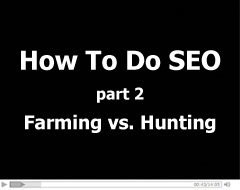%leftsidebar%
#macro:bloglist,3066,search,5#
To embed this video on your site copy and paste this code:
Last month I had the opportunity to present the benefits of a content rich website to a group of advertising agency principals at the ReCourses annual New Business summit. As part of the presentation I printed out all the content of our website to demonstrate the impact of the long tail of search. While the top level of our website, the pages linked off our main navigation, consists of about twenty pages or so, the supporting content, our years of newsletters, blog posts and our book, add well over a thousand pages.
When you look at search engine results to see where search traffic goes, you’ll notice that the majority of search hits are distributed across all these many pages, not just the home page. This list, printed from our Google Analytics reports, shows the exact search phrases where used to bring visitors to our site over a six month period. These are all the actual words typed into Google in which one of our pages showed up in the results and the searcher clicked to our site.
As you can see, this is a very long list. Very long.
Now as long as this list is, I only printed ten percent of it. The full list contains over 74,000 unique user sessions resulting from over 31,000 unique phrases. And if you examine the whole list you’d would see that the rarest phrases, those toward the end of the list that were used just once or twice, when added together, out contribute all the more popular search phrases at the top of the list. This is the power of search and the power of content.
%leftsidebar%
#macro:bloglist,3066,search,5#
Having lots of search traffic is great. But not every visit is of equal value. I mentioned search intent a quite few times last month. Let’s look at the real impact of matching search intent by examining our phrase performance.
Topping the list of popular phrases are variants of our company name. That’s not surprising since many people use Google as a navigation tool as well as a search engine. Rather than typing newfangled.com into their browser, they type newfangled into Google and get to us that way. These occurrences do reflect the level of engagement we have with people that already know about us.
But for measuring the impact of search engine optimization, I’m more interested in new discoveries of our site than I am those who already know about us and find us by name. All these other phrases are the words that bring potential new clients to our site.
I should be able to go to Google and find our site in the search results for each of the phrases in this list. Let’s try it for “power of words.” Yup, here we are, tenth in Google. We wrote a newsletter way back in 2004 about how words are a powerful commodity on the web. This page performs very well and has delivered over a thousand visits to our site in the past year. This is good but take a look at something else. See the phrase’s bounce rate? 70% of the time when people go to this page from Google they don’t go any further into our site.
And this makes sense. This newsletter is relevant to that phrase, but someone searching for information on “the power of words” is not likely also looking to hire a website development company. While that article may have met their search intent, the rest of the site is not relevant to them, so they read and go.
But look this phrase, “ajax websites.” The bounce rate is much lower. That’s because ajax is a technical approach to building certain kinds of websites. Someone searching on this phrase may very well be looking for a website developer with this capability. And since we have this capability (as implied by our newsletter “Ajax Website Applications“), the page fulfills the expectation of the searcher, so the visit is much more productive–even though the total number of visits that came from this phrase is lower. Rare phrases often out perform popular phrases.
%leftsidebar%
#macro:bloglist,3066,search,5#
Now remember how long that list was. There were over 74,000 sessions and 31,000 different phrases that contributed to our search traffic in that six month period. This is a vivid example of the long tail of search in action. In fact, we can get a visualization of this long tail by clicking on the chart view. See how the top performing phrases make up a good chunk of the visits. But look how quickly the high frequency phrases taper off and how long the unique phrases go on. And this list is only the top 250 of our 31,000 phrases.
That’s a lot of phrases. And here’s the interesting thing. Among this very long tail of infrequent phrases are sessions that have very low bounce rates. For example, the phrase
“building an ecommerce site” delivered traffic only twenty-six times in this date range, but check out its bounce rate–only 23% bounces. Or look at “website budget example,” the bounce rate is 0%. This is the result of matching search intent. If we were to tally the total number of very infrequent phrases that had very low bounce rates, we’d end up with a number of highly productive and effective results that, when combined, out-number our overall second best performing phrase, “power of words.” Again, you see, rare phrases often out perform popular phrases.
This is one reason why you don’t have to stress out too much about your exact keywords and phrases when doing SEO. Your best traffic is going to come from unique phrases that you would never have thought to optimize for in the first place. And that’s why even if you fall into the temptation to inaccurately title your content, the very words on the page will betray you. If you’re too ambitious in characterizing your titles, you’ll either not show up, or your visits will bounce. So go with the flow, be exact in characterizing your content, and enjoy the benefits of matching intent across the long tail of search.
%leftsidebar%
#macro:bloglist,3066,search,5#
Moving on from phrase performance let’s take a look at page performance.
We’ve already established that, discounting navigation traffic, the home page is not going to be our biggest performer. Usually, that’s because home pages don’t have targeted, focused, rich content. They usually have brief, general, overview copy. That’s okay; that’s what a home page should have. But it also means that content-rich sub-pages are the ones that will get most of the search engine attention. Google Analytics can help us discover which sub-pages are performing best.
We’ll need to finagle our Analytics settings a bit. From Traffic Sources I’ll stay with the Search Engines tab, but I need to make some adjustments.
First, I’m going to display only non-paid traffic. I’ve purchased AdWords in the past and these paid visits will show up as search traffic. I don’t want paid occurrences skewing my perspective on organic SEO so I’ll use this link to filter them out. I’ll also need to segment this list by “Landing Page.” Now the list changes from ‘phrases used’ to the ‘pages landed on.’ This list tells me which pages are performing best in search results.
I’ll also change the report to sort by bounce rate rather than total visits. I have to click it twice to get to a descending bounce rate list. I’m also going to make one other change. The top of this list is going to show many instances of 0% bounces. These are due to the fact that only one page was viewed–and many of these are the result of tracking URLs, internal site searches, and other unique features of our site. I’m going to exclude items containing URLs that indicate this activity. This will eliminate some of the noise, but not all of it. To get past this noise I’ll have to scroll down the list until I start to see instances with more than one occurrence.
Here we go…. These pages were clicked in search engine results and had the lowest bounce rates, or to put it another way they were the “stickiest” sessions. Pages like “Estimating Website Budgets,” “Ajax Website Designers,” “Website Prototype Technical Specification,” and many many more contribute to our best performing pages in terms of low bounce rates, number of sessions, unique visits, and time on site. These are the most meaningful results and instances of search engine success.
Notice again that these instances are spread out over many pages. In fact, this list of the top 500 pages represents just a third of all the instances that contributed to our search engine results. All these rare phrases are out performing the more popular phrases.
%leftsidebar%
#macro:bloglist,3066,search,5#
From time to time you may want to fine tune your search phrases and page titles. One way to evaluate whether or not to make a change is to view all the phrases that resulted in traffic to a particular page to see if there are words, wordings, or phrases you had not considered in your initial best guess. Let’s look at how this works on one of our pages. Let’s use “estimating website budgets.”
I have a couple ways of seeing which phrases resulted in traffic to specific pages. The easiest is the NewfangledCMS Google tracking application we have installed. Form the Google numbers I can open up the details and if I click the total number it will open a window that shows all the phrases used to get from
Google to this page. Not surprisingly “website budget” is the most frequently used phrase. My title is currently “Estimating a Website Budget.” If I search in Google using the phrase “website budget” I’m currently listed fifth. My on-page title is “How Much is a Website.” If I wanted to improve my ranking from fifth I could change my on-page title to “Website Budgets.” But in this case the on-page title “How Much is a Website” is the main title of the newsletter. And because I write for people, not primarily for search engines, I’m going to be content with fifth place and keep the current page title and browser title.
Besides, check this out. If I scroll down the list I start to see the long tail of search phrases that contributed to our overall traffic. If I count up those instances that resulted in only one or two visits, the long tail of unique phrases, I’ll see that the unique phrases, as a group, add far more to my overall traffic than the few phrases that are used more consistently. Here it is again, the rare phrases are out performing the popular.
Our Google tracker also has a cloud view of the word usage to see visually which words are most commonly used in search phrases that lead traffic to this page.
This is another example of not having to exert too much effort going after frequently used phrases. The many phrases we never even considered targeting end up out performing our intended phrase anyway. Due diligence and accuracy in optimization certainly helps, but adding new content regularly is by far the most fruitful activity for search engine optimization.
If you don’t have our Google tracker installed you can see the same page-based phrase list using Google Analytics. Go to the Content area and click on the Content by Title tab. You can use the search field at the bottom of the list to find a particular page, in this case “Estimating a Website Budget.” Click through to the detail screen for this page and then segment the report by Keyword. Again, we see the long tail of many keywords and phrases used to get traffic from Google to this particular page.
%leftsidebar%
#macro:bloglist,3066,search,5#
When you recognize the value of a farmer’s approach to SEO, you can start to see the irony in how most people approach SEO like hunters. They want to get lots of traffic to their home page for a few well-researched, prize keywords. This is going exactly opposite of how search engines work, as they try match many unique search phrases with many content-rich sub-pages.
A common consequence of upside down SEO expectation is too much emphasis on the home page as the first impression page, when in fact it’s every page other than the home page that are most likely to be the first impression page. Not nearly enough time is spent considering the overall impression and positioning of a sub-page
when it functions as the first page viewed–which they usually are.
Our May 2005 newsletter “Who’s Your Homepage” talk more about viewing sub-pages as surrogate home pages in terms of first impressions.
So you see there’s no big secret to search. Produce lots compelling content regularly. And as we talked about last month, be accurate and dispassionate about characterizing your titles. Translate a little to match how people search. And from time-to-time review your results in order to tweak. Keep it up, and like any diligent farmer, you’ll soon enjoy a rich harvest of search traffic.



